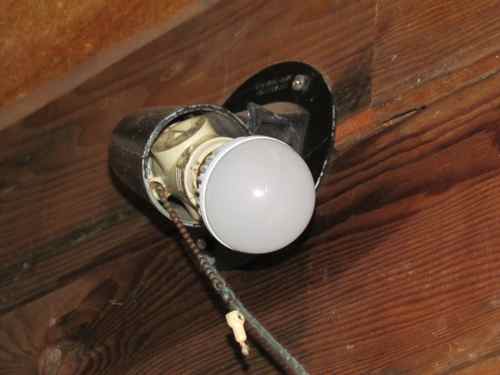There’s a late comer to our recent order of LED light bulbs to try out on the “homestead” (see Light Housekeeping: Concluded). The last bulb in the group arrived after I’d written and scheduled the light series. Now, at the risk of further belaboring an unexciting topic, I want to describe this bulb.
There’s a problem here. I ordered an E26 Screw Base 12 Volt AC/DC 5.6 Watt LED Light Bulb, (paid link) but the information on the box I received does not match this. According to the box, mine is an E27, 3 watt. Some of the other reviews on the page talk about getting a different bulb than the one ordered. They appear to come directly from China. As often seems to be the case in items from that source, there’s no telling what I actually received. So, this review is based on what I have in hand only!
I ordered this bulb before any of the others. Afterward, I compared it to the LED cluster bulbs (which I understand some people call “corn cobs” for obvious reasons) and began to regret my decision. Rated at 25 watts equivalent, this bulb appeared to provide very low light, an unfortunately common problem with LED bulbs.
Luckily, I badly misjudged the bulb.
When I opened the box and found a tiny bulb, less than 3″ long, my heart sank. Even so, I took it into the bedroom to try it out in the Edison socket on the wall.
We’ve had an older generation LED bulb in that socket for years, but we hardly ever use it. The bulb’s 11 LED cluster casts such feeble light it’s not worth pulling the chain. When I go into the bedroom, I almost always wear a headlamp. If not, I grab one of two flashlights I keep on my nightstand, or the flashlight attached to my keys.
I turned on the old lamp to remind myself of its light, then replaced it with the little bulb, barely half its size.
Then, as someone famous once said, “Let there be light!”
At a guess, this feisty little newcomer put out the same lumens as a 40 watt bulb, perhaps more; far brighter light than we are used to in that bedroom.
All this, at a draw of .2 amps. By way of comparison, our trimetric monitor draws the same amount, just to monitor the system. This is a cheap bulb, power wise!
We also checked the draw on one of the incandescent 12 volt bulbs we have. It takes 4.3 amps! Back in the box, power vampire!
The new bulb is constructed like a little tank, with a metal grill surrounding the base of a frosted plastic globe. I’m glad it’s frosted, because the shade we used on that light is the kind with the wires that clamp onto a standard size light bulb. I can hang it on this little bulb, but it’s loose enough to interfere with the pull cord. We’ll likely leave the bulb bare—less aesthetically pleasing, but worth the sacrifice to have a functioning light in that room at last.
As much as I like those corn cob LED clusters, we’re likely to use these miniature bulbs from now on, as they’re a few dollars cheaper, far more compact, lower draw, and have simpler construction. Reviews of the corn cobs show that some people have experienced individual LED burn outs. So far, we’ve not seen that, but we’re watching for it. Of course, it’ll be a good, long time before we use any of these new bulbs long enough to make a full evaluation.
